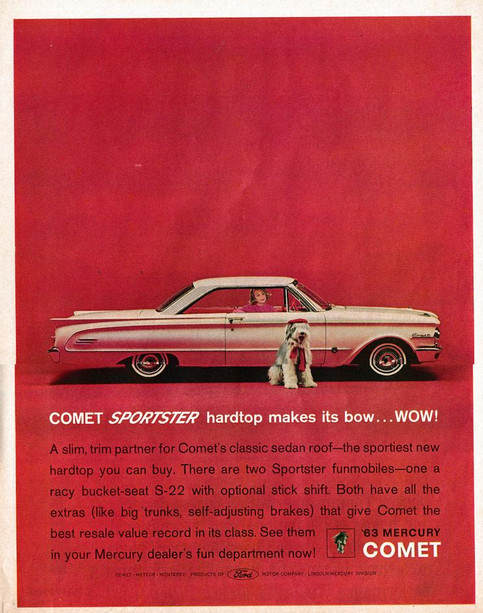This shot by Don Kincl (or was it Curtis Perry?) really shows the Comet’s long tail, thanks to the new semi-fastback roof that came out in 1963.5. The Comet was of course just a stretched Falcon, and that resulted in a length of a not inconsiderable 194.8″, or 14 inches longer than a ’63 Falcon. The wheelbase was extended at the rear from 109.4 to 114″, but the rest is additional overhang.
And the Sportster name? I’d forgotten that too.
Here’s the proof. It came in regular and S-22 versions. Our featured car appears to be the former. But it does have the optional 164 hp 260 V8, so there’s a bit of credence to its name.
The reskin for 1964 works a whole lot better for the Comet than it did for the Falcon.
























My mind continues to struggle with these. I always put the Comet in the same compact class as the Falcon, or maybe the slightly longer wheelbase Dart. But at some point I learned that these share the same 114 inch wheelbase as the 1964-67 GM A bodies. I know what the measurements say, but I cannot mentally place the Comet and, say, a Chevelle in the same size class. Something about the styling on these (particularly the earlier ones) says “small car” while that on the GM cars says “not small car.”
I have not looked it up, but suspect that the GM cars are wider, which would certainly have an effect on perceived size.
I’ve noticed the same impression. The Comet was the same size as the ’54 to ’56 Ford, but it looked much smaller. The ’62 Fairlane was also about the same size and looked even MORE compact somehow.
I guess it’s because the core of the greenhouse remained constant, although I also guess the more formal C-pillar let them slide the rear seat back a few inches. It was a jumped up compact, whereas the Fairlane/Meteor and GM A bodies were designed from the start as intermediates. Of course the Chrysler B bodies are their own strange kettle of fish…
I really love the ’64 and ’65 Comets, but the earlier ones are now becoming popular with the restomod people I think because of the common mechanicals with Falcon and Mustang but with a different flavor. They are “tweeners” in my view, something like 10″ shorter than the GM A bodies but with similar wheelbases. They are close in width. Put a “K” code solid lifter 289 in there with mandatory top loader 4 speed and 4:11 gears in the 9 inch and go hunt down some unsuspecting Chevy’s. Factory listed the K code in ’64 but in ’65 you had to go the DSO route which is similar to GM COPO and I believe 90 were built including 2 stripper 202 models.
I agree, I prefer the 64-65 Comets or Falcons, however I would go with a 363 engine, a 5 speed and depending on a bunch of variables so not sure what rear gear I would use. Torsen diff. The 363 is the largest you can go and still be in the original engine block size of the 289. All aluminum of course but painted to hide its true identity. 25% more and less weight to boot. Better start watching ebay and craigslist. The styling of the earlier Comets and Falcons just don’t do it, Falcons are too frumpy, like a 62 Galaxie and the Comets reminds me of the Edsels, wacked out styling that doesn’t make sense.
the Comet was supposed to be an Edsel.
Ah ha extra wheel base I didnt know that but it explains the difference somebody in Napier has a Comet from 64 a recent import and the difference with the few Falcons from OZ that survive is visually noticeable however I havent seen the two models together to compare
So did the extra inches in wheelbase give Comets more interior space than Falcons?
Those fender skirts do nothing for the looks of that Comet.
I guess it’s because the core of the greenhouse remained constant, although I also guess the more formal C-pillar let them slide the rear seat back a few inches. It was a jumped up compact, whereas the Fairlane/Meteor and GM A bodies were designed from the start as intermediates. Of course the Chrysler B bodies are their own strange kettle of fish…